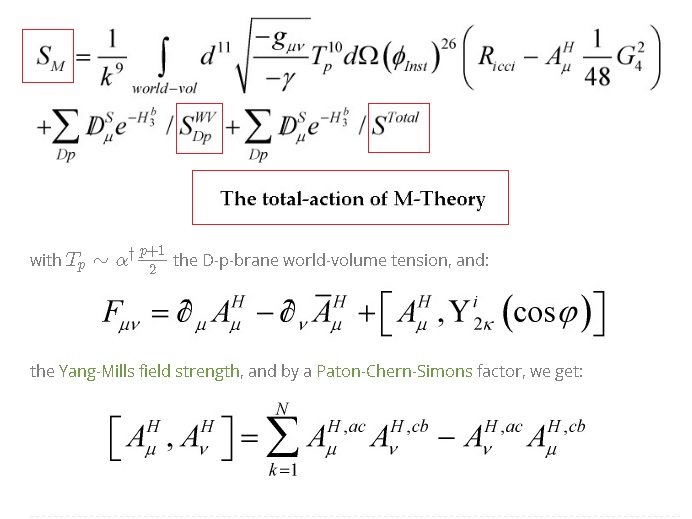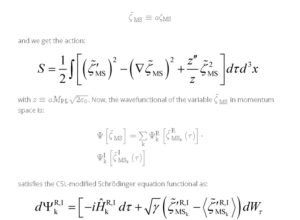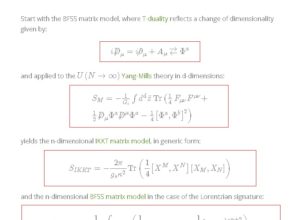Continuing from my work on the relation between Clifford algebraic symmetries and M-theory, here I will initiate an analysis of compactification via the derived Kähler-Atiyah bundle associated with Clifford-Kähler manifolds. Recall that whenever 2 or more D-branes coincide, there is a Clifford algebraic symmetry whose generators allow us to derive the total action:
![Rendered by QuickLaTeX.com \[\begin{array}{*{20}{l}}{{S^{Total}} = \frac{1}{{2\pi {\alpha ^\dagger }12}}\int\limits_{{\rm{world - volumes}}} {{d^{26}}} x{\mkern 1mu} d{\mkern 1mu} \Omega {{\left( {{\phi _{Inst}}} \right)}^2}\sqrt {\frac{{ - {g_{\mu \nu }}}}{{ - \gamma }}} {\mkern 1mu} {e^{ - {c_{2n}}/{\Upsilon _\kappa }(\cos \varphi )}} \cdot }\\{\left( {{R_{icci}} - 4{{\left( {{{\not D}^{SuSy}}\left( {{\phi _{Inst}}} \right)} \right)}^2}} \right) + \frac{1}{{12}}H_{3,\mu \nu \lambda }^bH_3^{b,\mu \nu \lambda }/A_\mu ^H + \sum\limits_{D - p - branes} {S_{Dp}^{WV}} }\end{array}\]](https://www.georgeshiber.com/wp-content/ql-cache/quicklatex.com-de32a0bee5bf92804d0e90a6cbfc05b9_l3.png)
and since D-p-branes are metaplectic solitons in closed string-theory, by the von Neumann boundary condition, there is a natural coupling of the super-Higgs field ![]() to the world-sheet of a string through its boundary:
to the world-sheet of a string through its boundary:
![Rendered by QuickLaTeX.com \[{S_{open}} = {S_{cld}} + \int\limits_{{\rm{end - points}}} {d\tau } A_\mu ^H{\bar X^\mu }{e^{ - H_3^b}}d{\mkern 1mu} \Omega {\left( {{\phi _{Inst}}} \right)^{\exp {\kern 1pt} ({c_{2n}}/{\Upsilon _\kappa }(\cos \varphi )}}\]](https://www.georgeshiber.com/wp-content/ql-cache/quicklatex.com-41bd517e58a76451dd6faf9af8bcf9c8_l3.png)
Hence, ![]() lives on a p+1 dimensional subspace with a
lives on a p+1 dimensional subspace with a ![]() contribution, yielding the world-volume action:
contribution, yielding the world-volume action:
![Rendered by QuickLaTeX.com \[S_{Dp}^{WV} = {S_{cld}} + \int\limits_{{\rm{end - points}}} {d\tau } A_\mu ^H{\bar X^\mu }d{\mkern 1mu} \Omega {\left( {{\phi _{Inst}}} \right)^2}{e^{ - \left( {H_3^b} \right)/{\Upsilon _\kappa }(\cos \varphi )}} + {e^{{c_{2n}}/{\Upsilon _\kappa }(\cos \varphi )}}/H_3^b\]](https://www.georgeshiber.com/wp-content/ql-cache/quicklatex.com-3ce1cd5197c586444540abb9db372b00_l3.png)
and since world-volumes have conformal invariance, by solving the n-loop level equation of motion:
![Rendered by QuickLaTeX.com \[\left\{ {\begin{array}{*{20}{c}}{{R_{\mu \nu }} = - \frac{1}{4}H_{3,\mu \lambda l}^bH_{3,\nu }^{b,\lambda \rho } + 2{{\not D}_\mu }^S{{\left( {{\phi _{Inst}}} \right)}^2}{{\not D}_\nu }^S{{\left( {{\phi _{Inst}}} \right)}^{1/2}}}\\{{{\not D}_\lambda }^S{\phi _{Inst}}H_{3,\lambda \mu \nu }^b - 4{{\not D}_\mu }^S{{\left( {{\phi _{Inst}}} \right)}^2}}\\{4{{\not D}_l}^S{\phi _{Inst}} - 4\left( {{{\not D}_\mu }^S{{\left( {{\phi _{Inst}}} \right)}^2}} \right) = {R_{icci}} + \frac{1}{{12}}{{\left( {H_3^b} \right)}^2}}\end{array}} \right.\]](https://www.georgeshiber.com/wp-content/ql-cache/quicklatex.com-eb97cb95cdcae13613debf11adf40a95_l3.png)
we get the total world-volume action:
![Rendered by QuickLaTeX.com \[\begin{array}{*{20}{c}}{S_{Dp}^{WV} = {\mkern 1mu} - {T_p}\int {{d^{p + 1}}} x{\mkern 1mu} {e^{ - {\phi _{Inst}}}}{\rm{Tr}}\left( {1 + \frac{1}{4}\left( {{F_{\mu \nu }} + d{\mkern 1mu} \Omega {{\left( {{\phi _{Inst}}} \right)}^2}} \right) + {{\left( {2\pi {\alpha ^\dagger }} \right)}^{ - 1}}{b_{\mu \nu }}} \right) \cdot }\\{\left( {A_\mu ^H + {{\left( {2\pi {\alpha ^\dagger }} \right)}^{ - 1}}{b_{\mu \nu }}} \right) + \frac{1}{2}{{\not D}^S}{\Upsilon _\kappa }(\cos \varphi ) - \frac{1}{4}\sum\limits_{i \times j} {\left[ {\Upsilon _{2\kappa }^i(\cos \varphi ,\Upsilon _{2\kappa }^j(\cos \varphi } \right]} \cdot }\\{\left[ {\Upsilon _{2\kappa }^j(\cos \varphi ),\Upsilon _{2\kappa }^i(\cos \varphi )} \right]}\end{array}\]](https://www.georgeshiber.com/wp-content/ql-cache/quicklatex.com-da646408038f8342e63c73630263ebf7_l3.png)
and since Clifford algebras are a quantization of target-space exterior algebras, via Gaussian matrix-elimination, we can expand, via Green’s-function, ![]() , the supersymmetry group covariant derivative, which I have redundantly simplified to
, the supersymmetry group covariant derivative, which I have redundantly simplified to ![]() and by supersymmetry, the total action of M-Theory becomes:
and by supersymmetry, the total action of M-Theory becomes:
![Rendered by QuickLaTeX.com \[\begin{array}{*{20}{l}}{{S_M} = \frac{1}{{{k^9}}}\int\limits_{world - vol} {{d^{11}}} \sqrt {\frac{{ - {g_{\mu \nu }}}}{{ - \gamma }}} T_p^{10}d\Omega {{\left( {{\phi _{Inst}}} \right)}^{26}}\left( {{R_{icci}} - A_\mu ^H\frac{1}{{48}}G_4^2} \right)}\\{ + \sum\limits_{Dp} {\not D_\mu ^S} {e^{ - H_3^b}}/S_{Dp}^{WV} + \sum\limits_{Dp} {\not D_\mu ^S} {e^{ - H_3^b}}/{S^{Total}}}\end{array}\]](https://www.georgeshiber.com/wp-content/ql-cache/quicklatex.com-e8948f3bebc96a4e78f2170d3abf8006_l3.png)
with ![]() the D-p-brane world-volume tension, and:
the D-p-brane world-volume tension, and:
![]()
the Yang-Mills field strength, and by a Paton-Chern-Simons factor, we get:
![Rendered by QuickLaTeX.com \[\left[ {A_\mu ^H,A_\nu ^H} \right] = \sum\limits_{k = 1}^N {A_\mu ^{H,ac}} A_\nu ^{H,cb} - A_\nu ^{H,ac}A_\mu ^{H,cb}\]](https://www.georgeshiber.com/wp-content/ql-cache/quicklatex.com-291c528ba8dc282e90c463543a6e6fb4_l3.png)
![]() the instanton field, with:
the instanton field, with:
![]()
here: ![]() .
.
In N=2 compactifications of 11-dimensional supergravity down to a 3-dimensional (anti)-deSitter space, the internal eight-D-manifold ![]() comes equipped with a Riemannian metric
comes equipped with a Riemannian metric ![]() and a Kähler 1-form
and a Kähler 1-form ![]() and a 4-form
and a 4-form ![]() encoding the 4-form field strength of the 11-dimensional theory. Moreover, the Majorana spinor is a section of the real spin bundle
encoding the 4-form field strength of the 11-dimensional theory. Moreover, the Majorana spinor is a section of the real spin bundle ![]() of
of ![]() . The background conserves exactly N=2 supersymmetry in 3-dimensions, equivalent to the condition that the real vector-space of solutions to the following differentio-algebraic system of generalized Killing spinor equations:
. The background conserves exactly N=2 supersymmetry in 3-dimensions, equivalent to the condition that the real vector-space of solutions to the following differentio-algebraic system of generalized Killing spinor equations:
![]()
is two-dimensional, with ![]() an endomorphism of
an endomorphism of ![]() :
:
![]()
![]() the Kähler connection on
the Kähler connection on ![]() , and
, and ![]() is the connection induced on
is the connection induced on ![]() by the Levi-Civita connection of
by the Levi-Civita connection of ![]() where:
where:
![]()
is an ![]() -valued 1-form on
-valued 1-form on ![]() , with:
, with:
![]()
with ![]() related to the cosmological constant
related to the cosmological constant ![]() of
of ![]() as:
as:
![]()
The F-motivated centrality of the chirality constraint:
![]()
allows the construction of the spin bundle ![]() of a (pseudo)-Riemannian manifold
of a (pseudo)-Riemannian manifold ![]() with signature
with signature ![]() of dimension
of dimension ![]() describable by an
describable by an ![]() -bundle of modules over the Clifford bundle
-bundle of modules over the Clifford bundle ![]() of the cotangent bundle of
of the cotangent bundle of ![]() endowed with a metric
endowed with a metric ![]() induced by
induced by ![]() . The initial problem is that the Clifford bundle is determined by
. The initial problem is that the Clifford bundle is determined by ![]() only up to isomorphism, so the association of
only up to isomorphism, so the association of ![]() to
to ![]() is not functorial. One typically goes around this problem by the invoking the Kähler-Atiyah Clifford-realization bundle of
is not functorial. One typically goes around this problem by the invoking the Kähler-Atiyah Clifford-realization bundle of ![]() .
.
This is the Chevalley-Riesz realization and it yields:
![]()
where ![]() is the exterior algebra of
is the exterior algebra of ![]() and the Clifford product of
and the Clifford product of ![]() is non-commutative, and the fiberwise multiplication on
is non-commutative, and the fiberwise multiplication on ![]() :
: ![]() , transforms
, transforms ![]() into the Kähler-Atiyah bundle
into the Kähler-Atiyah bundle ![]() .
.
Hence, the corresponding ![]() -grading admits an expansion into a finite sum of homogeneous-degree
-grading admits an expansion into a finite sum of homogeneous-degree ![]() binary operations
binary operations ![]() satisfying:
satisfying:
and the parity automorphism ![]() is given by:
is given by:
![]()
with:
![]()
the Kähler-Atiyah generalized products.
Hence, the expansion:
is a semiclassical expansion of the geometric product yielding a geometric quantization where the Planck constant is inversely related to the scale of the metric ![]() , thus allowing us to derive:
, thus allowing us to derive:
![]()
with ![]() the interior product.
the interior product.
Hence, our spin bundle ![]() can be interpreted as a bundle of modules over the Kähler-Atiyah bundle of
can be interpreted as a bundle of modules over the Kähler-Atiyah bundle of ![]() , with the module structure defined by a morphism of bundle of algebras:
, with the module structure defined by a morphism of bundle of algebras:
![]()
where ![]() is fiberwise-irreducible.
is fiberwise-irreducible.
With ![]() the local
the local ![]() -frame,
-frame, ![]() the dual
the dual ![]() -co-frame, satisfying:
-co-frame, satisfying:
![]()
with:
![]()
the space of smooth inhomogeneous globally defined differential forms on ![]() , and a form
, and a form ![]() expands as:
expands as:
![Rendered by QuickLaTeX.com \[\omega = \sum\limits_{k = 0}^d {{\omega ^{\left( k \right)}}} { = _U}\sum\limits_{k = 0}^d {\frac{1}{{k!}}\omega _{{a_1}...{a_k}}^{\left( k \right)}} {e^{{a_1}...{a_k}}}\]](https://www.georgeshiber.com/wp-content/ql-cache/quicklatex.com-b10a818d5bbb9ab59edb239b223ab37c_l3.png)
![]()
with:
![]()
A real spinors-bundle over ![]() is an
is an ![]() -vector bundle
-vector bundle ![]() over
over ![]() that is also a bundle of modules over the Clifford bundle
that is also a bundle of modules over the Clifford bundle ![]() .
.
Since we have no loss of generality by assuming that ![]() is orientable with
is orientable with ![]() the volume form satisfying
the volume form satisfying ![]() , the bundle decomposition is hence:
, the bundle decomposition is hence:
![]()
and the ![]() -submodules of
-submodules of ![]() yield:
yield:
![Rendered by QuickLaTeX.com \[\begin{array}{l}{\Omega ^ \pm }\left( M \right)\overbrace = ^{{\rm{def}}}\Gamma \left( {M,{{\left( { \wedge {T^ * }M} \right)}^ \pm }} \right) = \\\left\{ {\omega \in \Omega \left( M \right)\left| {\omega \circ \nu = \pm \omega } \right.} \right\}\end{array}\]](https://www.georgeshiber.com/wp-content/ql-cache/quicklatex.com-e175c5935fa3b1d18c95360b63675068_l3.png)
as well as:
![]()
where ![]() is implicitly defined by:
is implicitly defined by:
![]()
which is a surjective mapping, and since Clifford algebras are a quantization of target-space exterior algebras of the Kähler-Atiyah bundle, the Kähler-Atiyah algebra is hence:
![]()
Without any loss of generality, we can stick to dealing with ![]() a Riemannian 8-manifold that is the compactification space of M-theory down to 3 dimensions or a 9-manifold corresponding to the metric cone over an eight-dimensional compactification space. Hence, the fiberwise representation given by
a Riemannian 8-manifold that is the compactification space of M-theory down to 3 dimensions or a 9-manifold corresponding to the metric cone over an eight-dimensional compactification space. Hence, the fiberwise representation given by ![]() is equivalent to an irreducible representation of the real Clifford algebra
is equivalent to an irreducible representation of the real Clifford algebra ![]() or
or ![]() in a 16-dimensional
in a 16-dimensional ![]() -vector space, which is surjective, and thus we have:
-vector space, which is surjective, and thus we have:
![]()
which is a map that identifies the bundle of endomorphisms of ![]() with the bundle of algebras:
with the bundle of algebras:
![]()
and so every globally-defined endomorphism:
![]()
admits a dequantization:
![]()
that defines a differential form on ![]() , yielding
, yielding ![]() of the dequantizations of
of the dequantizations of ![]() .
.
We can now define the Fierz isomorphism of bundles of algebras:
![]()
with:
![]()
the bi-spinor bundle. On fiber sections, we hence have an isomorphism of ![]() -algebras:
-algebras:
![]()
identifying the bi-spinor algebra ![]() with the subalgebra
with the subalgebra ![]() of the Kähler-Atiyah algebra.
of the Kähler-Atiyah algebra.
Let us now define the inhomogeneous differential forms:
![Rendered by QuickLaTeX.com \[\left\{ {\begin{array}{*{20}{c}}{{{\mathord{\buildrel{\lower3pt\hbox{$\scriptscriptstyle\smile$}} \over E} }_{\xi ,\xi '}}\overbrace = ^{{\rm{def}}}\mathord{\buildrel{\lower3pt\hbox{$\scriptscriptstyle\smile$}} \over E} \left( {\xi \otimes \xi '} \right) \in {\Omega ^{\tilde \gamma }}\left( M \right)}\\{\xi ,\xi ' \in \Gamma \left( {M,S} \right)}\end{array}} \right.\]](https://www.georgeshiber.com/wp-content/ql-cache/quicklatex.com-115ad88b429637d38e3c6da739fa2740_l3.png)
Here is where Clifford-Kähler manifolds come in. The corresponding properties of the Fierz isomorphism, the algebraic constraint ![]() and the generalized Killing spinor equations
and the generalized Killing spinor equations ![]() yield the following conditions on the inhomogeneous differential forms
yield the following conditions on the inhomogeneous differential forms ![]() , which hold for any global section:
, which hold for any global section:
![]()
satisfying:
![]()
![]()
where the dequantization of the globally defined endomorphism
![]()
and
![]()
the adjoint dequantization, is:
![]()
and:
![]()
are the Kähler-Atiyah derivatives given by:
![]()
with ![]() the Levi-Civita connection of
the Levi-Civita connection of ![]() induced on
induced on ![]() , which yield us the Fierz identities:
, which yield us the Fierz identities:
![]()
that define, via Clifford-Kähler fibration, the Kähler-Atiyah sub-algebra of ![]() .
.
Now, this class of equation:
![]()
lifts ![]() to the metric cone over
to the metric cone over ![]() , which can be interpreted as the warped product:
, which can be interpreted as the warped product:
![]()
with warp factor:
![]()
with the corresponding Kähler 1-form:
![]()
We can now identify the spin bundle ![]() of the metric cone over
of the metric cone over ![]() with the pullback of
with the pullback of ![]() through the natural projection:
through the natural projection:
![]()
by defining the lift ![]() of
of ![]() to be the connection on
to be the connection on ![]() obtained via
obtained via ![]() on the pullback to the cone. Hence,
on the pullback to the cone. Hence, ![]() can be written as:
can be written as:
![]()
where ![]() is the
is the ![]() -connection induced by the Levi-Civita connection of
-connection induced by the Levi-Civita connection of ![]() . Hence, the Schur algebra associated with our Clifford algebra
. Hence, the Schur algebra associated with our Clifford algebra ![]() is isomorphic to
is isomorphic to ![]() and
and
the corresponding spin representation:
![]()
is surjective. The morphism ![]() is completely determined once the signature
is completely determined once the signature ![]() is fixed. With no loss of generality, we can take it to be:
is fixed. With no loss of generality, we can take it to be: ![]() , and by a shift-rescaling, on
, and by a shift-rescaling, on ![]() , of the metric:
, of the metric:
![]()
we can deduce the conical equations:
![]()
![]()
and
![]()
And crucially, the Killing spinor equations:
![]()
for spinors defined on ![]() :
:
![]()
for m = 1 … 8, yield the Clifford-Kähler manifold flatness conditions:
![]()
![]()
Notice also, that the conic-flatness equation:
![]()
is equivalent to the condition that the section ![]() of
of ![]() is the Clifford-pullback of a section
is the Clifford-pullback of a section ![]() of
of ![]() through the Kähler-Atiyah projection
through the Kähler-Atiyah projection ![]() from
from ![]() to
to ![]() , and the remaining equations are fundamentally the generalized Killing conditions:
, and the remaining equations are fundamentally the generalized Killing conditions:
![]()
Thus, the Kähler-Atiyah algebra of cones generalizes Killing spinors on the Clifford-Kähler algebras and after fribrations, we obtain the desired N=2 compactifications of M-theory down to three dimensions conified on:
![]()




